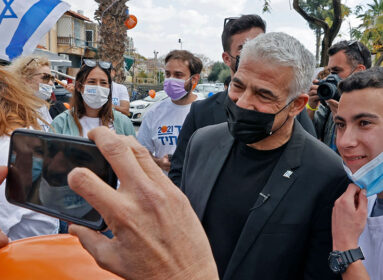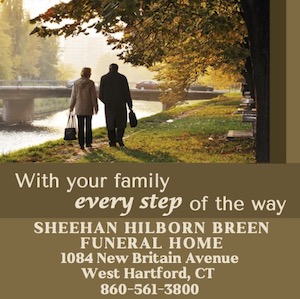By Cindy Mindell ~
BRIDGEPORT – Among the cornerstones of a traditional Jewish community is caring for the dead. Considered the highest mitzvah one can perform – because the beneficiary cannot express thanks or reciprocate – preparing a body for burial has historically been the purview of the “chevra kadisha,” Aramaic for “holy society.”
Specially trained volunteers administer the halachic prescription for preparing a body after death: “tahara,” purification through ritual cleansing; wrapping the body in “tachrichim,” a simple white burial garment; and “shmira,” watching and praying over the body until it is buried in the ground – either directly or in a plain wood coffin, so that the body returns to dust.
Like many halachic requirements adapted and transformed over time by liberal Jewish denominations, chevra kadisha has been evolving in the U.S. for at least 100 years.
“In Europe, every community had its own chevra kadisha, and as Jews immigrated to this country and started communities, they established cemeteries and chevrot kadisha,” says Rabbi Yechezkel Schlingenbaum of the Chevra Kadisha of New Haven. “But my impression is that, as members of the chevra kadisha became older and passed away, the younger generation of Jews was not interested in getting involved.”
And so, starting in the 1940s, many non-Orthodox American Jewish congregations let go of the chevra kadisha, Schlingenbaum says, handing over funeral arrangements to funeral directors, some of whom were not knowledgeable in halachic Jewish burial practices. But over the last 30 or 40 years, Reform and Conservative Jewish congregations have begun to reclaim the mitzvah.
Schlingenbaum, who first became involved in chevra kadisha in the late ‘60s as a Queens yeshiva student, helped revive the communal burial society in New Haven a decade later. He says that the development of the group mirrors the phenomenon in many Jewish communities, its presence evolving from a communal organization to a synagogue-based one and back.
When Schlingenbaum arrived in New Haven, only the Young Israel congregation maintained a chevra kadisha. Together with Prof. Sidney Leiman of the Yale Judaic Studies department, Schlingenbaum, Rabbi David Avigdor of Bikur Cholim Sheveth Achim Synagogue, and others helped revive the Chevra Kadisha of New Haven. Schlingenbaum wrote a guide with the help of Rabbi Elchanan Zohn of the National Association of Chevra Kadisha, who was teaching at a yeshiva high school in New Haven at the time. (Zohn is still considered by many in the Orthodox community to be the “go-to” source of halachic wisdom for funeral and burial requirements.)
Why do Jews observe “kavod ha-met,” respect for the dead? “If I’m interacting with somebody alive and breathing, I should treat that individual in a dignified manner, but if I have a lifeless body in front of me that serves no purpose, why demonstrate respect?” says Schlingenbaum. There are two reasons.
For one, while alive, a person performed various mitzvot, for which he or she will be rewarded in the next world and it is impossible to do a good deed without the use of one’s physical body.
Secondly, the Torah teaches that human beings were created in the image of God, a reference primarily to the soul, the essence of every person. “Neshama” is related to “neshima,” breath; the Torah says that God breathed the soul into Adam, which brought him to life. “Being that, for our entire existence in this physical world, the body contains this soul that is a reflection and image of God, we attain a very high level of sanctity even if the neshama isn’t in the body, which is enough of a reason to show respect for the body,” Schlingenbaum says. “When the body dies, the neshama still feels a connection to it and stays near it until the burial, when it returns to God.” Through the soul, the deceased is still aware of how the body is being treated, Schlingenbaum says. Mistreatment causes the individual pain; respectful treatment brings a sense of satisfaction.
The two models of chevra kadisha – communal and synagogue-based – are evident in Jewish communities throughout Connecticut. The Chevra Kadisha of Greater Hartford is comprised of observant members who are called on by rabbis or funeral directors when a family requests halachic funeral and burial rites.
“Most of us feel that it’s our responsibility to take care of our own,” says a member who preferred to remain anonymous. “I liken the experience to something I saw in Israel: a mother with a carriage and an infant will get onto a bus via the rear entrance. She hands her baby to the first person she sees, a total stranger, and walks to the front of the bus to pay her fare. In Israel, just as everyone takes care of their own and watches out for everyone else, at this point in life, this is what we have to do as well.”
In New London, Congregation Beth El, a Conservative synagogue, and Chabad of Eastern Connecticut, each has an in-house group of trained volunteers who administer tahara; family members and fellow congregants will often sit with the body until burial.
Members of Congregation Mishkan Israel (CMI) in Hamden, a Reform temple, organized several years ago to offer shmira to fellow congregants, studying chevra kadisha rites and putting together a booklet of Psalms to read while watching over a body.
The group coalesced even more in 2009 and again in 2011, when Army Capt. Ben Sklaver of Hamden and Army Pfc. Eric Soufrine of Woodbridge were killed in action in Afghanistan.
“It was such an incredible tragedy in both cases,” says Rabbi Herbert Brockman of CMI. “Ben’s family told me that two soldiers knocked on the door and gave them the information that their son had died. His mother mentioned to me that the one thing she felt most comfortable with is that the Army guaranteed that Ben would always be escorted until he was picked up at Dover Air Force Base. I told her, ‘We Jews do that too.’”
In both cases, many congregants came forward to watch over the body before burial. “What we learned as a community was how powerful that act is for the parents of the deceased, for the shomrim [the guardians], and hopefully, for the deceased,” Brockman says.
Now the communal chevra kadisha is making a comeback among the liberal congregations of Eastern Fairfield County. In June, 50 members of the Jewish community gathered at the JCC in Bridgeport for an information session on the tradition, sponsored by the local board of rabbis and facilitated by Jackie Stromer of Kavod v’Nichum, an organization that educates communities about chevra kadisha.
The burial society has a long history in Bridgeport. In a 2002 interview with Kavod v’Nichum, Rabbi Mosha Epstein of Congregation Agudas Achim chronicled the chevra kadisha since his arrival in 1966.
Then, he says, “tahara was still something the rabbis did not do. The funeral home had a tahara group…. They were reliable, but elderly and very secretive. They didn’t talk about who was in the chevra kadisha or the procedures they used. By the middle 1980s, most of the older people who had been doing tahara either died or moved away. We had to bring in a group from New York City to do the tahara.”
By the mid-‘90s, Epstein and fellow Jewish communal leaders began to research what it would require to reestablish a communal chevra kadisha, studying existing handbooks and interviewing former members of the local group, as well as burial societies in New York, Boston, and Detroit. Epstein wrote “Tahara Manual of Practices,” first published in 1995 by the newly formed Chevra Kadisha Zichron Shabtai Leib of Greater Bridgeport, and now in its third, updated publication. As with the earlier group, those participating in the new society had to keep Shabbat; others could serve as helpers.
Epstein summarized the most significant points of the sacred society’s duties for Kavod v’Nichum: “Understand the importance of Tahara: this is Jews taking care of Jews. We can’t leave the prayers, the washing, and the dressing to others. We must address the fear of death. Our individual lives are limited, but our collective life continues. Rabbi Rackovsky [writing in Epstein’s manual] says, ‘The ceremonies for the care of the deceased, and in particular the tahara ceremony, affirm the continuity of existence. The ceremony communicates that the integrity and essence of every Jew who ever lived is maintained forever.’”
Organizers of the most recent greater Bridgeport initiative are planning three training sessions, to be led by Kavod v’Nichum’s Stromer.
“Being Jewish in a non-Jewish world, we experience wakes and the Christian narrative of what happens when you die,” says Rabbi Daniel Victor of Congregation Rodeph Sholom. “We’re finding that people in our community want to know what the Jewish narrative is; they want to know how you care for the body, that the body deserves our kindness and respect – and not just because the soul is contained within, but because the body is a gift and, in learning how to respect it to the end, Judaism teaches us how to face death.”
As a communal chevra kadisha, the group will be able to serve members of the various area synagogues, Victor says, and meet specific requests of bereaved families.
“For example, a member of Rodeph Sholom can request that the coordinator call the chevra kadisha members from Rodeph Sholom first when the time comes,” he says. “Many people take comfort in knowing that, in death, they will be cared for by those who knew and loved them in life.”








 Southern New England Jewish Ledger
Southern New England Jewish Ledger










